Math A level Syllabus, 2016
Circle
 | A circle is easy to make: Draw a curve that is "radius" away from a central point. And so: All points are the same distance from the center. |
You Can Draw It Yourself
Put a pin in a board, put a loop of string around it, and insert a pencil into the loop. Keep the string stretched and draw the circle! | 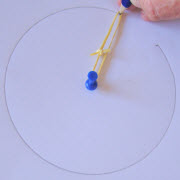 |
Radius, Diameter and Circumference
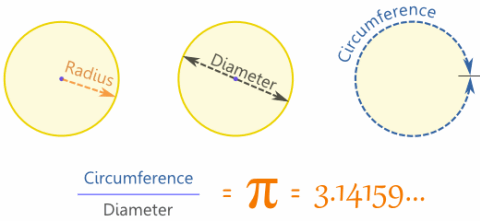 The Radius is the distance from the center to the edge.The Diameter starts at one side of the circle, goes through the center and ends on the other side.The Circumference is the distance around the edge of the circle.And here is the really cool thing:
The Radius is the distance from the center to the edge.The Diameter starts at one side of the circle, goes through the center and ends on the other side.The Circumference is the distance around the edge of the circle.And here is the really cool thing:

So when the diameter is 1, the circumference is 3,141592654... | 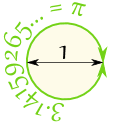 |
We can say:
Circumference = π × Diameter
Example: You walk around a circle which has a diameter of 100m, how far have you walked?
Also note that the Diameter is twice the Radius:Diameter = 2 × RadiusAnd so this is also true:Circumference = 2 × π × Radius
Remembering
The length of the words may help you remember:- Radius is the shortest word
- Diameter is longer (and is 2 × Radius)
- Circumference is the longest (and is π × Diameter)
Definition
The circle is a plane shape (two dimensional): And the definition of a circle is: |  |
The set of all points on a plane that are a fixed distance from a center.
Area
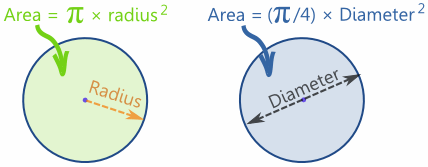 The area of a circle is π times the radius squared, which is written:A = π r2
The area of a circle is π times the radius squared, which is written:A = π r2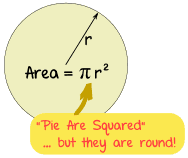
To help you remember think "Pie Are Squared"
(even though pies are usually round)Or, using the Diameter:A = (π/4) × D2


To help you remember think "Pie Are Squared"
(even though pies are usually round)
Example: What is the area of a circle with radius of 1,2 m ?
Area Compared to a Square
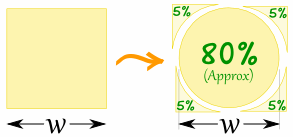 A circle has about 80% of the area of a similar-width square.
A circle has about 80% of the area of a similar-width square.
The actual value is (π/4) = 0,785398... = 78,5398...%

The actual value is (π/4) = 0,785398... = 78,5398...%
Names
Because people have studied circles for thousands of years special names have come about.Nobody wants to say "that line that starts at one side of the circle, goes through the center and ends on the other side" when a word like "Diameter" will do.So here are the most common special names: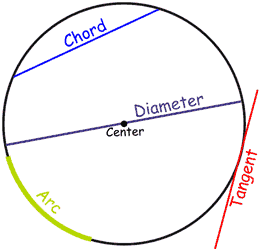

Lines
A line that goes from one point to another on the circle's circumference is called a Chord.If that line passes through the center it is called a Diameter.A line that "just touches" the circle as it passes by is called aTangent.And a part of the circumference is called an Arc.
Slices
There are two main "slices" of a circle. The "pizza" slice is called a Sector. And the slice made by a chord is called a Segment. | 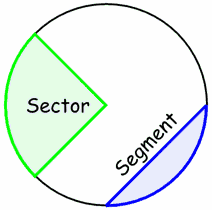 |
Common Sectors
The Quadrant and Semicircle are two special types of Sector:
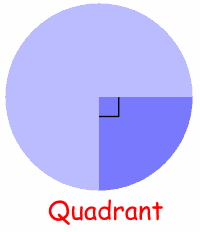 | Quarter of a circle is called a Quadrant. Half a circle is called a Semicircle. |
 |
Inside and Outside
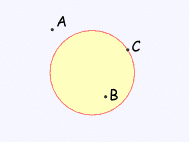 | A circle has an inside and an outside (of course!). But it also has an "on", because we could be right on the circle. Example: "A" is outside the circle, "B" is inside the circle and "C" is on the circle. |
Radians
The angle made when we take the radius and
wrap it along the edge of the circle:
wrap it along the edge of the circle:
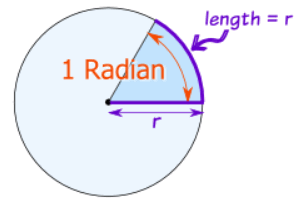
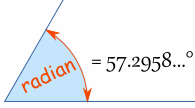 | 1 Radian is about 57,2958 degrees. |
Why "57,2958..." degrees? We will see in a moment.
The Radian is a pure measure based on the Radius of the circle:
Radian: the angle made when we take the radius
and wrap it along the edge of a circle.
and wrap it along the edge of a circle.
Radians and Degrees
Let us see why 1 Radian is equal to 57,2958... degrees:
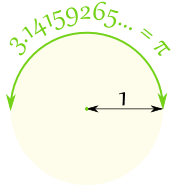
In a half circle there are π radians, which is also 180°
| So: | π radians | = | 180° | |
| So: | 1 radian | = | 180°/π | |
| = | 57,2958...° | |||
| (approximately) |
To go from radians to degrees: multiply by 180, divide by π
To go from degrees to radians: multiply by π, divide by 180
Here is a table of equivalent values:
| Degrees | Radians (exact) | Radians (approx) |
|---|---|---|
| 30° | π/6 | 0,524 |
| 45° | π/4 | 0,785 |
| 60° | π/3 | 1,047 |
| 90° | π/2 | 1,571 |
| 180° | π | 3,142 |
| 270° | 3π/2 | 4,712 |
| 360° | 2π | 6,283 |
Radians Preferred by Mathematicians
Because the radian is based on the pure idea of "the radius being laid along the circumference", it often gives simple and natural results when used in mathematics.
For example, look at the sine function for very small values:
| x (radians) | 1 | 0,1 | 0,01 | 0,001 |
|---|---|---|---|---|
| sin(x) | 0,8414710 | 0,0998334 | 0,0099998 | 0,0009999998 |
For very small values. "x" and "sin(x)" are almost the same
(as long as "x" is in Radians!)
(as long as "x" is in Radians!)
There will be other examples like that as you learn more about mathematics.
Conclusion
So, degrees are easier to use in everyday work, but radians are much better for mathematics.
Circle Sector and Segment
SlicesThere are two main "slices" of a circle:
|  |
Try Them!
| Sector | Segment |
|---|---|
Common Sectors
The Quadrant and Semicircle are two special types of Sector:

Half a circle is
a Semicircle.

Quarter of a circle is
a Quadrant.
Area of a Sector
You can work out the Area of a Sector by comparing its angle to the angle of a full circle.
Note: we are using radians for the angles.
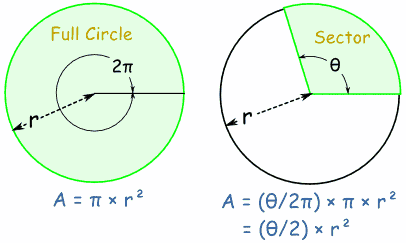
This is the reasoning:
| A circle has an angle of 2π and an Area of: | πr2 | |
| A Sector with an angle of θ (instead of 2π) has an Area of: | (θ/2π) × πr2 | |
| Which can be simplified to: | (θ/2) × r2 |
Area of Sector = ½ × θ × r2 (when θ is in radians)
Area of Sector = ½ × (θ × π/180) × r2 (when θ is in degrees)
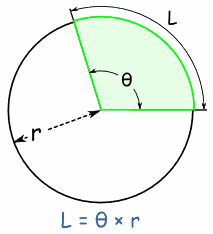 | Arc LengthBy the same reasoning, the arc length (of a Sector or Segment) is: L = θ × r (when θ is in radians) L = (θ × π/180) × r (when θ is in degrees) |
Area of SegmentThe Area of a Segment is the area of a sector minus the triangular piece (shown in light blue here). There is a lengthy reason, but the result is a slight modification of the Sector formula: | 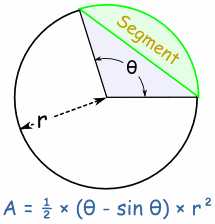 |
Area of Segment = ½ × (θ - sin θ) × r2 (when θ is in radians) Area of Segment = ½ × ( (θ × π/180) - sin θ) × r2 (when θ is in degrees) | |
exercise 1
Exercise 2


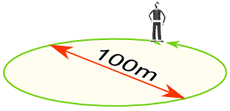







.jpg)






0 comments:
Post a Comment